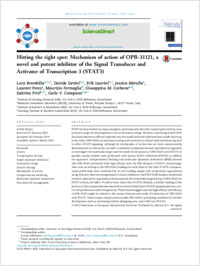Hitting the right spot : mechanism of action of OPB‐31121, a novel and potent inhibitor of the Signal Transducer and Activator of Transcription 3 (STAT3)
- Brambilla, Lara Institute of Oncology Research (IOR), Faculty of Biomedical Sciences, Università della Svizzera italiana, Switzerland
- Genini, Davide Institute of Oncology Research (IOR), Faculty of Biomedical Sciences, Università della Svizzera italiana, Switzerland
- Laurini, Erik Molecular Simulation Laboratory (MOSE), University of Trieste, Trieste, Italy
- Merulla, Jessica Institute of Oncology Research (IOR), Faculty of Biomedical Sciences, Università della Svizzera italiana, Switzerland
- Perez, Laurent Institute for Research in Biomedicine (IRB), Faculty of Biomedical Sciences, Università della Svizzera italiana, Switzerland
- Fermeglia, Maurizio Molecular Simulation Laboratory (MOSE), University of Trieste, Trieste, Italy
- Carbone, Giuseppina M. Institute of Oncology Research (IOR), Faculty of Biomedical Sciences, Università della Svizzera italiana, Switzerlandd - Oncology Institute of Southern Switzerland (IOSI), Bellinzona, Switzerland
- Pricl, Sabrina Molecular Simulation Laboratory (MOSE), University of Trieste, Trieste, Italy
- Catapano, Carlo V. Institute of Oncology Research (IOR), Faculty of Biomedical Sciences, Università della Svizzera italiana, Switzerland - Oncology Institute of Southern Switzerland (IOSI), Bellinzona, Switzerland
-
05.03.2015
Published in:
- Molecular oncology. - 2015, vol. 9, no. 6, p. 1194-1206
STAT3
Transcription factors
Small molecule inhibitors
Anticancer drugs
Cancer therapy
Mechanism of action
Computational modeling
Molecular dynamic simulation
Site-directed mutagenesis
English
STAT3 is a key element in many oncogenic pathways and, like other transcription factors, is an attractive target for development of novel anticancer drugs. However, interfering with STAT3 functions has been a difficult task and very few small molecule inhibitors have made their way to the clinic. OPB‐31121, an anticancer compound currently in clinical trials, has been reported to affect STAT3 signaling, although its mechanism of action has not been unequivocally demonstrated. In this study, we used a combined computational and experimental approach to investigate the molecular target and the mode of interaction of OPB‐31121 with STAT3. In parallel, similar studies were performed with known STAT3 inhibitors (STAT3i) to validate our approach. Computational docking and molecular dynamics simulation (MDS) showed that OPB‐31121 interacted with high affinity with the SH2 domain of STAT3. Interestingly, there was no overlap of the OPB‐31121 binding site with those of the other STAT3i. Computational predictions were confirmed by in vitro binding assays and competition experiments along with site‐directed mutagenesis of critical residues in the STAT3 SH2 domain. Isothermal titration calorimetry experiments demonstrated the remarkably high affinity of OPB‐31121 for STAT3 with Kd (10 nM) 2–3 orders lower than other STAT3i. Notably, a similar ranking of the potency of the compounds was observed in terms of inhibition of STAT3 phosphorylation, cancer cell proliferation and clonogenicity. These results suggest that the high affinity and efficacy of OPB‐ 31121 might be related to the unique features and mode of interaction of OPB‐31121 with STAT3. These unique characteristics make OPB‐31121 a promising candidate for further development and an interesting lead for designing new, more effective STAT3i.
- Language
-
- English
- Classification
- Medicine
- License
-
License undefined
- Open access status
- gold
- Identifiers
-
- RERO DOC 326867
- DOI 10.1016/j.molonc.2015.02.012
- ARK ark:/12658/srd1319046
- Persistent URL
- https://n2t.net/ark:/12658/srd1319046
Statistics
Document views: 143
File downloads:
- Texte intégral: 215
